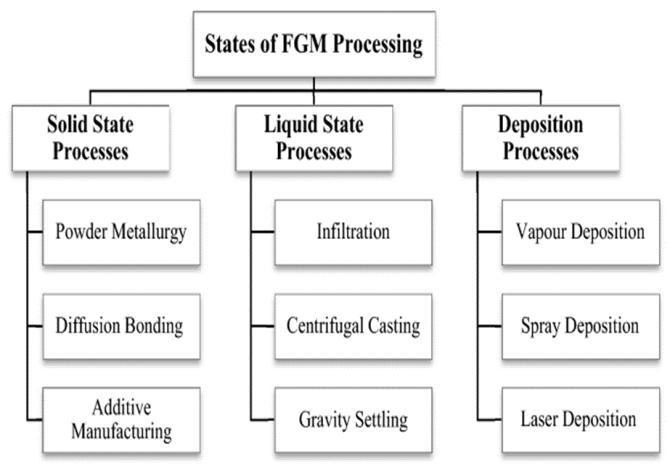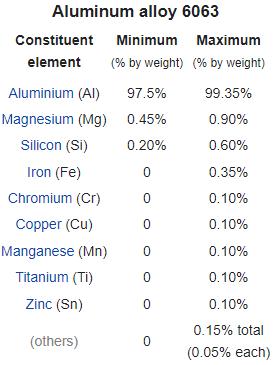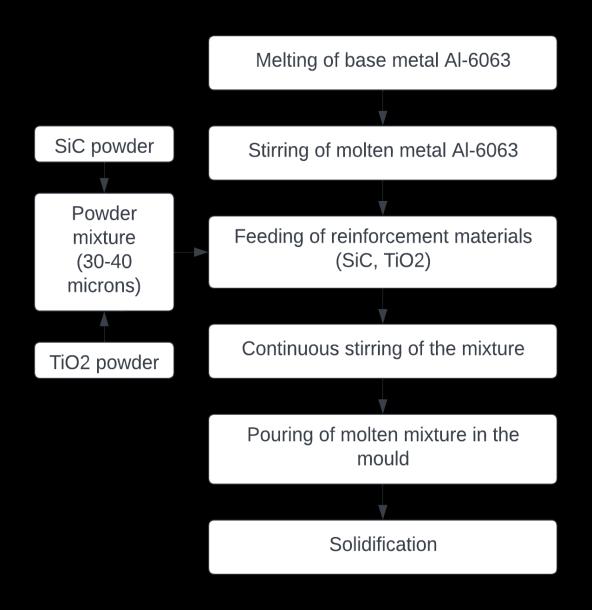1Dr Manjunath BT Asst professor Department of Mechanical Engineering Dayananda sagar college of engineering Bengaluru Karnataka india
***
Abstract - Functionally GradedMaterials(FGM)belongstoa class of advanced composite materials i.e, characterized by variations in composition, microstructures as well as properties across the dimension of the materials. They have been developed as ultrahigh temperature resistant materials for biological, chemical, aerospace and other engineering applications. Inthis project, thepreparationofmetalalloy(AlSiC-TiO2) functionally graded material using stir casting process. The siliconcarbide andtitanium Dioxideareaddedto aluminium-6063 and the samples in the ratios of 2%(SiC), 3%(TiO2) to 95%(AL6063) and 4%(SiC), 3%(TiO2) to 93%(AL6063) and 6%(SiC), 3%(TiO2) to 91%(AL6063) by weight percentage using powder metallurgy process for manufacturing casting. Since our major concentrationhere is to identify the microstructures and mechanical properties of Al-SiC-TiO2, the Stir casting process is selected for constant mixing at 60RPM of the mentioned elemental powders to produce alloy samples. Then they are examined with the help of metallurgical microscope to know about the porosity and fusion of the grains. The fabricated specimen is subjected to tensile, hardness, wear tests. As per result obtained from tensile test states that as Al-6063 decreases, the yield and ultimate strength increases due to increase in ductility of material. The result obtained from hardness test states that hardness increases with increase in reinforcement material. The result obtainedfrom wear teststatesthatwithdecreasein AL-6063 and increase in percentage of Sic, wear of the material also decreases.
1. INTRODUCTION

FGMs (functionally graded materials) are one-of-a-kind materials with features and attributes that change in proportion to their size. It's a more advanced form of previouslyusedcompositematerialsthatcombinestwoor more elements to provide the desired properties for the application. FGMs have gotten a lot of interest from academics in the recent decade because of their graded propertiesateverysinglepointinseveraldimensions.The features and attributes of a FGM differ from the elements thatmakeitup.
1.1 STATE OF FGM PROCESSING:-
According to the state of FGM processing, methods are separatedintothreecategories:solidstateprocedures,liquid stateprocesses,anddepositiontechniques.Figure1.2shows themanyprocessingmethodsthatfallintothesegroups.A large amount of research exists that spans all phases of processing in various FGM manufacturing techniques. Deposition techniques are cutting-edge technology for makingsmall-scale,high-precisionitems.Forhighlystressed thermo-mechanical components, solid-state FGMS is used, whereasliquid-statemethodsareusedforbigproductswith less property control. Temperature impacts, mechanical loading, pressure, and inertia forces that occur during productionwhenFGMismadeinvariousmethodsandstates haveanimpactonthefinalproduct'squality.

1.2 FGM FIDELS OF APPLICATION:-
FGMs have been found and used in a variety of applications,includingbothsevereworkingconditionsand very sensitive applications. Examples include heat exchangers,heat-resistantmaterialsinspacecraftorfusion reactors, and medical implants. Various combinations of typically incompatible activities can be employed to manufacturenewmaterialsforaeroplanes,chemicalplants,
“Evaluation of Mechanical properties for Functionally Graded Material base metal Aluminum [AL - 6063] when reinforced with Silicon Carbide [SiC] and Titanium Dioxide [TiO2]”Dr Manjunath BT1 , Hineeth Kumar SP2 , 2Hineeth Kumar sp student Department of Mechanical engineering Dayananda sagar college of engineering Bengaluru karnataka india
nuclearenergyreactors,andotherpurposes.Dependingon their use, FGMs are classified as biomaterial aircraft, car, cuttingtools,nuclearreactor,smartstructureturbineblades, andsportsequipment.

1.4 SILICON CARBIDE (SiC):-
Siliconcarbide(SiC)isahardchemicalcombinationmadeup ofsiliconandcarbon.Itisalsoknownascarborundum.They maycontainsomesurplussiliconorcarbon,aswellasasmall amount of oxygen, depending on the production method. Strongtensilestrength,lowweight,highchemicalresistance, high temperature tolerance, and stiffness are all characteristics of silicon carbide. Elastic modulus is a mechanicalproperty(410GPa).
1.5 TITANIUM DIOXIDE (TiO2):-


AL-6063 is an aluminium alloy comprising the alloying elementsmagnesiumandsilicon.TheAluminiumAssociation maintainsthestandardthatgovernsitscomposition.Ithas strong mechanical qualities and may be heat treated and welded.Itpossessesthreeoutstandingfeaturesthatmakeit particularlyvaluableintheaviationbusiness.
Ductility, non-corrosive, lightweight but robust, good heat andelectricconductivity
ThemostprevalentalloyforaluminiumextrusionisAL-6063. Itisusedforvisiblearchitecturalapplicationslikeaswindow frames, door frames, and roofs because it permits complicateddesignstobecreatedwithverysmoothsurfaces that are suitable for anodizing. Tensile strength (215MPa) andshearstrengtharemechanicalqualities(152MPa).
Titanium dioxide is an inorganic substance having the chemicalformulaTiO2.Itisalsoknownastitanium(IV)oxide ortitania.Titaniumwhiteisthenamegiventoitwhenused as a pigment. Its melting and boiling points are both extraordinarilyhigh.Itoccursnaturallyasasolid,anditis insolubleinwatereveninparticleform.TiO2isaninsulator as well. Young's Modulus (333MPa), Tensile Strength (230GPa).
1.6 METALLURGICAL MICROSCOPE
Aspecializedmicroscopeusedtoexaminemetaltargetcrosssections (metallurgical mounts). These metallurgical microscopes are often inverted and use high-resolution objective lenses with low working distances. While these systemsareeffectiveforthissortofanalysis,theirrangeof applicationsissomewhatlimited.Metallurgicalmicroscopes, whetheropticalordigital,canbeemployedinpracticallyany businessorfieldofresearchthatrequirestheobservationof shinymetalsurfaces.Metallurgy,mineralogy,andgemology are among them. Manufacturers also use digital or optical metallurgical microscopes to look for faults or wear on materialsandcomponents.
2. LITERATURE SURVAY
[1]AnujKumaretal[2017]wereabletodeterminethewear characteristics of an aluminium matrix composite by reinforcing copper and silicon carbide in aluminium. The wearbehaviourofAl-SiC-CuMMCisinvestigatedforvarious reinforcementcontent,load,speed,anddistance.
[2]PSivaiahandKVenkataChalapathi[2014]investigated theattractiveness,waitratio,andstrengthofAL-SiCpMMC, which is widely utilised in the aerospace and automotive sectors.ThemechanicalpropertiesandmicrostructureofAlalloys with 5 percent, 10%, and 15% Sicp weight are examined in this research. In an electrical furnace, the compositions were mixed to their final form and used to manufacture aluminium metal matrix composites. The fabricatematerialwillbetestedonbhn,rockwell,hardness, tensile,torsion,andimpactatvarioussicpcompositionsto getmechanicalproperties.
[3]V.DanielJebin1andD.Shivalingappa[2013]investigated wear behaviour of AL-6063 alumina metal matrix composites, which are often utilised in the automobile industry.Thewearresistanceofthesematerialsispoor.The useofaluminiumoxideasareinforcingmaterialhasresulted in the creation of durable and wear-resistant composites. The goal of this research was to employ a pin-on-disc machine to investigate the wear behaviour of an Al 6063 aluminiumalloymatrixcompositewithvariousparameters. WhentheweightpercentofAluminumoxidewasraised,the wearratewaslowered.
[4] S.A. Balogun, S.O. Adeosun, and O.S. Sanni [2004] The strength and ductility of aluminium alloy 6063 reinforced with silicon carbide granules were investigated after cold rolling and heat treatment. To prepare samples for heat treatmentandcoldrolling,siliconcarbide(SiCp)withagrain size of 100 m was added to 6063 aluminium in volume fractions of 0–30%. The findings reveal that rolled-andtempered samples containing 10% SiCp may achieve an optimalcombinationofstrengthandductilityat137.92MPa andreal strainof0.173.Thisisasignificantimprovement over the 6063 aluminium alloy, which hasa true strain of 0.18andhasanultimatetensilestrengthof100MPa.
[5] P.V.Rajesh and S.Roseline [2016] The goal of this research is to look at the mechanical characteristics of an aluminium alloy (Al6063) based hybrid metal matrix compositereinforcedwithsiliconcarbide,magnesium,and fly ash that was made using the stir casting process. The samplespecimenswerecreatedbyalteringthereinforcing fraction in relation to the aluminium alloy. Mechanical characteristics analysis reveals differences in tensile strength, hardness, and impact strength across composite combinations.Thepercentagesofaluminium,siliconcarbide, magnesium,andflyashshouldbe90,5,5,and0accordingly to achieve optimal tensile, hardness, and impact qualities, accordingtothetestingresults.
[6]A.godwinAntony,V.Vijayan,S.Saravanan,S.Baskarand M.Loganathan [2018] performed research in the field of material science and engineering. That by fabricating aluminiummatrixcompositeswithtitanium(Ti)andsilicon carbide (Sic) by stir casting process and the wear characteristicsarefoundoutbycarryingout“PinonDisk” test. In the current study Aluminium is used as the basis metalanditisreinforcedwithsiliconcarbideandtitanium particlesusingthestircastingprocess.TheEdoxtestwillbe usedtoexaminethealuminiumscrap,whichwillthenbestir cast with titanium and silicon carbide added as reinforcements.Later,a"pinondisc"testiscarriedoutto determinethecomposites'wearqualities.Thecomposites are put through a SEM test to determine their wear characteristics.Finally,aSEMexaminationisperformedto examinethegrainstructure.
[7] B. Suresh Babu, P. Prathap, T. Balaji, D. Gowtham, S.D. SreeAdi,R.DivakarandSanjeevRavichandran[2020]Inthis

study,themechanicalandmetallurgicalcharacteristicsofAl 6063-SiliconCarbideandAl6063-SiliconCarbide/Graphite hybridmetalmatrixcompositematerialsarefabricatedand compared. The composites were made using stir casting procedures,withreinforcementamountsrangingfrom5% to 15% in 5 wt.% increments each sample. Mechanical characteristics,density,andmicrostructuralinvestigations areusedtodescribethecomposites,whicharethentested according to ASTM criteria. The composites' optical microphotographsshowaconsistentdistributionofhybrid particlesinthecomposites, withfewclusters.Inall ofthe composites, the experimental densities were found to be lowerthanthepredicteddensities.ThedistributedSilicon Carbide and Graphite in the Al 6063 alloy improved the composites'tensilestrength(MPa).Thesampleswerefound tohaveahomogeneousdistributionofhybridreinforcement particles(SiC.andGraphite)inthematrix,withnotunnelor void effects, according to scanning electron microscopy (SEM)investigation.
[8] k. k. alaneme and m. o. bodunrin [2013] researched where Aluminum-based matrices remain the most researchedmetalmatrixmaterialforthecreationofMMCs amongmetallicmatrices.Thisisowingtothewiderangeof qualitiesthataluminum-basedmatrixcompositesprovideat a cheap processing cost. The mechanical behaviour of aluminiumalloy(6063)-aluminaparticlecompositesmade by two-step stir casting was studied. AA 6063 – Al2O3 particlecompositeswith6,9,15,and18%Al2O3byvolume were created. It was discovered that AA 6063/Al2O3p composites with low porosity ( 3.51% porosity) and an excellentuniformdispersionofaluminaparticlesintheAA 6063 matrix could be made. The tensile strength, yield strength,andhardnessincreasedwithincreaseinalumina volume percent while the strain to fracture and fracture toughness decreased with increasing volume percent alumina.
3. METHOD AND METHODOLOGY

COMPOSITE1:-95%(AL–6063)+2%(SiC)+3%(TiO2)
COMPOSITE2:-93%(AL–6063)+4%(SiC)+3%(TiO2)
COMPOSITE3:-91%(AL–6063)+6%(SiC)+3%(TiO2)
320, 400, 600.Once grinding is done the specimen is thoroughly washed in water. Now fine scratches are removedbyusingarotarypolishingmachine.Itisrubbedin asoftmoistvelvetclothmountedontherotatingdiscwith aluminiumoxidepowder.Thispolishingprocessisdonefor 2minstraight.Oncepolishingisdonespecimeniscleaned withsoapsolutioninultrasoniccleaner.Beforemountingon microscopeetchingreagentsisaddedontothesurfaceofthe specimenwherethesolutioncontains10%picricacid+90% alcohol.Nowthespecimenismountedonthemetallurgical microscope and is magnified to 100μm and the image is recorded.Nowtherecorded3imageofdifferentcomposite iscomparedforporosityandfusionofgrains.
9. CONCLUSION AND FUTURE SCOPE
Wecancomeuptothefollowingconclusionsbased onthetestsperformed.ThroughWeartest,wecan conclude that the wear of the material decreases with the increase in SiC percentage. Hence, it is proved that the wear resistance can be improved reinforcing SiC. The yield strength and ultimate strengthincreaseswithdecreaseinpercentageof Al-6063 and increase in percentage of SiC when TiO2isconstant.Hardnessdecreaseswithdecrease in the percentage of Al-6063 and increase in percentage of SiC when TiO2 kept constant. Microstructureanalysisshowsthatwithdecreasein Al-6063percentageandincreaseinSiCpercentage thechangeingrainstructureandimprovementin ductility. For future scope, we can keep SiC percentage constant and increase in TiO2 percentage with base metal Al-6063 and perform differenttest

10. REFERENCES
[1] B. Suresh Babu et al., “Studies on mechanical propertiesofaluminumbasedhybridmetalmatrix composites,” Mater. Today,vol.33,pp.1144–1148, 2020.
[2]P.Harish,V.M.Srikanth,P.RavindraBabu,M.R. Ch, and K. Kishore Kumar, “Characterization of mechanicalandtribologicalpropertiesofaluminum alloy based hybrid composites reinforced with cottonshellashandsiliconcarbide.

8 .PREPARATION OF THE SPECIMEN
Forthismicrostructuralanalysishardnesstestspecimenof dimensions of 20mm in length and 8mm in diameter is selected.Fine grinding of the specimen is carried out on waterproofemery/sandpaperofgridsize(220,320,400, 600)immersedinwater.Thespecimenisrubbedbackand forthodtheentirepaperimmersedinwaterfor10minin eachpaper,washedandrubbedagainintheorderof220,
[3]X.Yao,Y.F.Zheng,J.M.Liang,andD.L.Zhang, “Microstructuresandtensilemechanicalproperties of an ultrafine grained AA6063–5vol%SiC metal matrix nanocomposite synthesized by powder metallurgy,” Mater. Sci. Eng. A Struct. Mater., vol. 648,pp.225–234,2015.
[4]B.Bakthavatchalam,K.Habib,N.Patil,andO.A. Hussein, “Microstructural analysis of Al6063/sic

with calcium additives for hardness enhancement,” MATECWebConf.,vol.225,p.03007, 2018.
[5] P. V. Rajesh and S. Roseline, “Experimental investigationofmechanicalpropertiesofaluminium alloyal6063basedhybridmetalmatrixcomposite.
[6] P. Sivaiah, C. Reddy, and K. V. Chalapathi, “Fabricationandstudyofmechanicalpropertiesand microstructureofAl6063-SICpmmc.
[7] A. K. Srivastava, “Assessment of mechanical properties and EDM machinability on Al6063/SiC MMC produced by stir casting,” Mater. Today, vol. 25,pp.630–634,2020.
[8]K.L.Meena,D.A.Manna,D.S.S.Banwait,andD. Jaswanti,“Ananalysisofmechanicalpropertiesof thedevelopedAl/SiC-MMC’s,” Am. J. Mech. Eng.,vol. 1,no.1,pp.14–19,2013.
[9]M.B.A.Shuvho,M.A.Chowdhury,M.Kchaou,B. K. Roy, A. Rahman, and M. A. Islam, “Surface characterization and mechanical behavior of aluminumbasedmetalmatrixcompositereinforced with nano Al2O3, SiC, TiO2 particles,” Chem. Data Coll.,vol.28,no.100442,p.100442,2020.
[10] R. Ashok Kumar and T. S. Krishnakumar, “Casting and characterization of Al6063/SiC nano composites produced using stir casting method,” Mater. Today, vol. 5, no. 11, pp. 23853–23862,2018.
[11] A. Karthikeyan and S. Nallusamy, “Experimentalanalysisonslidingwearbehaviourof aluminium-6063withSiCparticulatecomposites,” Int.j.eng.res.Afr.,vol.31,pp.36–43,2017.
[12]N.Lokesh,B.Manoj,K.Srikanth,P.V.Kumar,P. K. V. Ramanayya, and M. V. Rao, “Mechanical characterization of stir cast Al 6063 TiO2-cu reinforcedhybridmetalmatrixcomposites,”Mater. Today,vol.5,no.9,pp.18383–18392,2018.

[13] K. Velavan and K. Palanikumar, “Effect of SiliconCarbide(SiC)onstircastaluminiummetal matrixhybridcomposites–Areview,”Appl.Mech. Mater.,vol.766–767,pp.293–300,2015.
[14]M.B.A.Shuvho,M.A.Chowdhury,N.Hossain, B.K.Roy,M.A.Kowser,andA.Islam,“Tribological study of Al-6063-based metal matrix embedded withSiC–Al2O3–TiO2particles,”SNAppl.Sci.,vol.2, no.2,2020.
[15] J. Hindi, A. U. Kini, S. S. Sharma, B. M. Gurumurthy,andM.C.GowriShankar,“Mechanical characterization of stir cast Al 6063 matrix SiC reinforcedmetalmatrixcomposites,”2015,pp.69–73.
